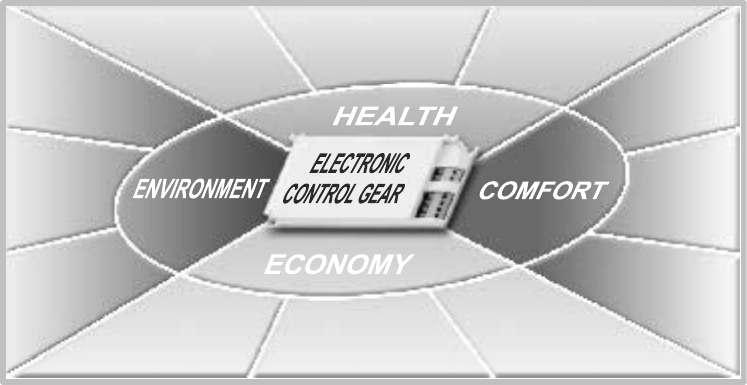Instruction manual

9
ballast is responsible for preheating the lamp electrodes, for sufficient
ignition voltage and for limiting the lamp current.
1.4 Different Principles,
Different Behavior
The basic functions that are mentioned in chapter 1.3, can usually be
carried out with electromagnetic (inductive) ballasts. These ballasts are
classified into conventional control gear (CCG) and low loss ballasts (LLG).
The latter follow the same principle as CCG, however, due to different
engineering design they consume less energy. The much better solution is
to operate fluorescent lamps with Electronic Control Gear (ECG). Besides
the advantages of flicker-free lighting, longer lamp life and higher system
efficacy (lamp + ECG), features such as lamp ignition, limitation of the lamp
current and compensation are integrated into the ECG. Most Electronic
Control Gear are also suitable for DC operation, which means they can be
used in emergency lighting installations.
T5/ ∅ 16 mm fluorescent lamps FH
®
…HE, FQ
®
…HO and FC
®
can only be
operated by Electronic Control Gear.
If fluorescent lamps are operated with magnetic ballasts (principle of
magnetic coil, CCG and also low loss ballast), the lamp current equals the
frequency of the mains voltage. The resulting stroboscopic effect can be
dangerous in cases where people work with rotary machines. Every time,
the voltage goes through zero, the lamp current does the same until the
lamp is reignited: for every lamp ignition new carriers for the electric charge
have to be build up within the gas discharge.
1.5 Advantages of
Electronic Control Gear
1.6 Saving Energy with
Electronic Control Gear
When using Electronic Control Gear the frequency of the lamp voltage is
approx. 1000 times higher than the line voltage. The zero of the lamp
current are passed so quickly that the average of the value of the electron
density is nearly constant within the discharge plasma. The electrons don’t
have to be built up with every cycle (as it is necessary when using CCG
and low loss ballasts). So the limitation of the lamp life due to reignition
peaks for CCG operation are avoided with ECG operation. Therefore no
stroboscopic effects can occur by using high frequency control gear as
there is no longer a gap in the lamp current. Therefore, one lamp type
needs less energy to generate the same lumens when operated with high
frequency control gear compared to operation with magnetic ballasts. The
lower energy consumption reduces the lamp load and increases the lamp
OPERATION WITHOUT
NOISE
LONGER LAMP LIFE
(approx. + 50%)
CALM AND
FLICKERFREE
LIGHT
ENERGY SAVING
(25 – 30%)
LOW MAGNETIC
STRAYFIELD
LOW
WIRING COSTS
LONGER
LAMP LIFE
(approx. 50%)
DIMMABLE
(spec. version)
LOWER
ENERGY
CONSUMPTION
(25 – 30%)
FLICKERFREE
START
LESS WASTE
DISPOSAL
(approx. 30%)
AUTOMATIC
SWITCH OFF AT END
OF LAMP LIFE
OPERATION WITHOUT
NOISE
LONGER LAMP LIFE
(approx. + 50%)
CALM AND
FLICKERFREE
LIGHT
ENERGY SAVING
(25 – 30%)
LOW MAGNETIC
STRAYFIELD
LOW
WIRING COSTS
LONGER
LAMP LIFE
(approx. 50%)
DIMMABLE
(spec. version)
LOWER
ENERGY
CONSUMPTION
(25 – 30%)
FLICKERFREE
START
LESS WASTE
DISPOSAL
(approx. 30%)
AUTOMATIC
SWITCH OFF AT END
OF LAMP LIFE










